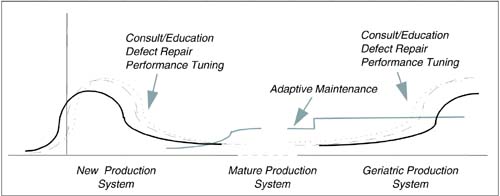Passages: The Life Cycle of Production Systems
| It is a common belief that as people get older they start behaving like children again. This phenomenon is also found in buildings , most classes of products, roads , computer hardware, and systems. In fact, by careful monitoring of the production system costs, a very clear pattern of "life stages" emerges for the majority of production systems. 1. New Product or System: ChildhoodAs we discussed in Chapter 18, all new products or systems exhibit the same patterns of work effort. On implementation, there is a peak of three categories of support work:
The duration of this peak depends on a complex relationship between product or system size and quality. 2. Mature Product or System: AdulthoodAfter the product or system has stabilized, the most common form of support activity will be adaptive maintenance. Depending on the life of the product or system, there may be a requirement for an additional activity, upgrade and conversion. In addition, there will be ongoing, lower, and generally predictable levels of the following activities:
During the mature stage, the product or system will be subjected to enhancements, which lead to increased complexity and size of the production product. This continuous expansion also results in periods of new system behavior as new components are stabilized. 3. Old Product or System: Geriatric [2]
Most interestingly, after a period of " healthy " adulthood, production systems begin to show signs of aging. Because of the lack of maintenance of product or system documentation; the departure of developers, experts, or programmers who developed the original system; the inexperience of the support people or maintenance programmers; and the increasing complexity of the system caused by numerous enhancements and turnover of business clients , the support of the product or system begins to suffer. Defect repair effectiveness (i.e., the number of defects introduced by the correction of existing defects) begins to fall and the system begins to "age" more quickly (see Figure 19.1). Figure 19.1. Passages of product or system life cycle |
EAN: 2147483647
Pages: 136
